
The Nokia 9210 Communicator is a third-generation Communicator series mobile phone produced by Nokia, announced on 21 November 2000 and released in June 2001. It greatly improved on the second generation Nokia 9110 Communicator, providing a colour main screen and using an ARM processor. It is one of the few mobile phones able to send and receive fax.

The Nokia N90 is a smartphone, announced as part of Nokia's then-new line of multimedia devices, Nseries, on April 27, 2005. It had a unique swivel design encompassing four 'modes'. It has two displays and has a camera with Carl Zeiss optics and integrated flash, and can record video with audio. The screen can be swiveled 270° to mimic the appearance of a camcorder. The camera lens can also be swiveled. The 2.1-inch display has a pixel density of 259 ppi, considered the most crispest Nokia screen at the time, and continued to be joint-highest with the N80, E60 and E70 for four years, before being beaten by the Nokia N900 in 2009 with 267 ppi. The Nokia N90 can print with some printers over USB or over Bluetooth.
Nokia Browser for Symbian was the default web browser for the S60 and Symbian mobile phone platform. The browser is based on a port of Apple Inc.'s open-source WebCore and JavaScriptCore frameworks which form the WebKit rendering engine that Apple uses in its Safari Web browser.
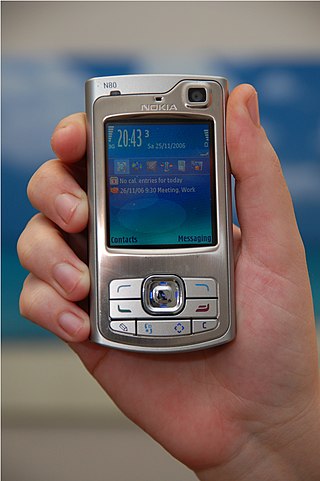
The Nokia N80 is a 3G mobile phone from Nokia announced on November 2, 2005, part of the multimedia Nseries line. It runs on Symbian OS v9.1 and the S60 3rd Edition interface. It was first released in June 2006.

The Nokia 3250 is a mobile phone running Symbian OS v9.1, announced on 26 September 2005. It features a unique 'twist' design that transforms the traditional phone keypad into a camera and dedicated music control keys. It was marketed as a music phone and can store up to 2 gigabytes of music and other data thanks to a microSD memory card slot, and features a two-megapixel camera as well as other smartphone capabilities.

The Nokia N93 is a smartphone from Nokia, part of the multimedia Nseries. It was introduced on 25 April 2006 and released in July 2006. It runs on Symbian OS v9.1 and the S60 3rd Edition interface. It was the most advanced camera phone from Nokia at the time of its release, and was particularly marketed for its swivel design like its predecessor Nokia N90, which mimics the appearance of a conventional camcorder.

The Nokia Eseries consists of business-oriented smartphones running Symbian OS, with emphasis on enhanced connectivity and support for corporate e-mail push services, as well as enterprise-styled products and many featuring QWERTY keyboards. All devices have advanced office features through its S60 platform. Phones equipped with Wireless LAN also provide a VoIP client. Throughout the series' lifetime its main competitors were BlackBerry products from Research In Motion. The Eseries was marketed until 2011.
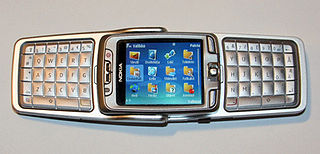
The Nokia E70 is a candybar/fold keyboard-type mobile phone from the Eseries range, announced in October 2005 and released in May 2006. There are two models of this phone, the E70-1 for the world market with tri-band GSM and UMTS, and the E70-2 for the Americas with tri-band GSM and EDGE packet data capability. Both models use the S60 platform 3rd Edition on top of Symbian OS version 9.1.
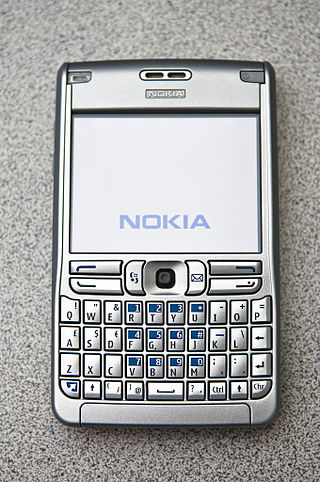
The Nokia E61 is a smartphone from the Eseries range, a S60 3rd Edition device targeting business users in the European market. It was announced as part of the new Eseries business line on 12 October 2005 along with the Nokia E60 and E70. As of Q4 2006, Cingular and Rogers Wireless deployed a similar yet restricted version designated the Nokia E62 in the North American and Brazilian markets. The E62 is substantially similar but without an 802.11 WiFi chipset or W-CDMA (UMTS) 3G support. E61 supports 900/1800/1900 bands, while E62 can operate in 850/900/1800/1900 in order to support American networks.

The Nokia N95 is a mobile phone produced by Nokia as part of their Nseries line of portable devices. Announced in September 2006, it was released to the market in March 2007. The N95 ran S60 3rd Edition, on Symbian OS v9.2. It has a two-way sliding mechanism, which can be used to access either media playback buttons or a numeric keypad. It was first released in silver and later on in black, with limited edition quantities in gold and purple. The launch price of the N95 was around €550.

Nokia E51 is a Symbian OS mobile phone by Nokia announced on 18 September 2007 as the replacement of the Nokia E50 in the business-focused Eseries line. It was the second Nokia UMTS / HSDPA dual band device. The phone was available with a black, silver or bronze-coloured border and backplate. It has a slim body made of stainless steel, and was the smallest Nokia smartphone of the time, yet is still technologically capable like other S60 devices of the time. A version without the integrated camera also existed. The E51 was highly acclaimed and was succeeded by the Nokia E52.

The Nokia E71 is a smartphone introduced on 8 May 2008 from the Eseries range with a QWERTY keyboard targeting business users worldwide. It runs on Symbian OS v9.2, with a Series 60 3rd Edition, second generation Feature Pack 1. The Nokia E71 succeeded the Nokia E61/61i models, building on the base design and form factor but enhancing on the feature set.
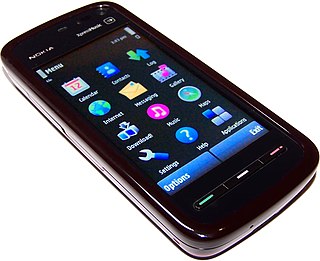
Nokia 5800 XpressMusic is a smartphone part of the XpressMusic line, announced by Nokia on 2 October 2008 in London and started shipping in November of that year. Code-named "Tube", it was the first touchscreen-equipped S60 device by Nokia – essentially it was the first device to run Symbian^1, also known as S60 5th Edition, the touch-specific S60-based platform created by the Symbian Foundation. The touchscreen features tactile feedback.

The Nokia E66 is a slider mobile phone in the Nokia Eseries range, a S60 platform third edition device with slide action targeting business users. It is a successor to the Nokia E65 with which it shares many features.
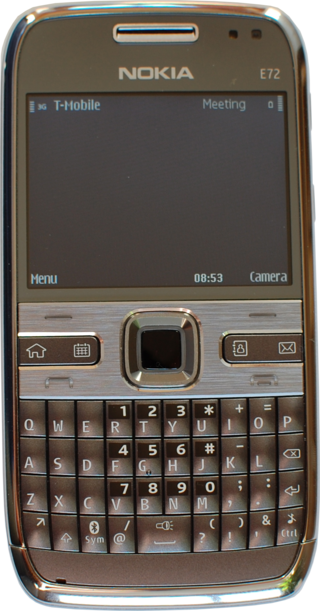
The Nokia E72 is a smartphone from the Nokia Eseries range manufactured in Finland. The Nokia E72 was announced on June 15, 2009 at the Nokia Connections 2009 event in Singapore. It is the successor to the Nokia E71 and is based on a similar design and form factor, and offers a similar feature set. The Nokia E72 is a business-oriented phone and has standard features including mobile email, calendar and instant messaging among many others with its Symbian-based S60 3rd Edition Feature Pack 2 operating system.

Symbian is a discontinued mobile operating system (OS) and computing platform designed for smartphones. It was originally developed as a proprietary software OS for personal digital assistants in 1998 by the Symbian Ltd. consortium. Symbian OS is a descendant of Psion's EPOC, and was released exclusively on ARM processors, although an unreleased x86 port existed. Symbian was used by many major mobile phone brands, like Samsung, Motorola, Sony Ericsson, and above all by Nokia. It was also prevalent in Japan by brands including Fujitsu, Sharp and Mitsubishi. As a pioneer that established the smartphone industry, it was the most popular smartphone OS on a worldwide average until the end of 2010, at a time when smartphones were in limited use, when it was overtaken by iOS and Android. It was notably less popular in North America.

The Nokia N8 is a touchscreen-based smartphone developed by Nokia. Announced on 27 April 2010, the Nokia N8 was the first device to run on the Symbian^3 mobile operating system and it was the company's flagship device for the year. It was released on 30 September 2010 at the Nokia Online Store before being released in markets around the world on 1 October 2010. There were two version made, the N8 and the N8-00. The N8 was made for Vodafone and locked to its networks, and the N8-00 was made by Microsoft and open network.

The Nokia 3650, sold in North American markets as the Nokia 3600, is a mobile phone from Nokia announced on 6 September 2002 as the successor to the Nokia 7650. It runs Symbian OS Series 60.
Nokia's strategic nomenclature can be traced back in 2005 when the Nseries line was launched, offering devices with flagship specifications and premium hardware at various price points. These devices were considered the "bread and butter" of the company and were often positioned to showcase their latest technologies. Thanks to the newfound consumer and enterprise interest in smartphones at the time, the company introduced four additional collections to diversify their product portfolio and meet demands in most market segments. These new phone series were named Eseries, targeting small business and enterprise customers; Xseries, providing consumer-grade multimedia-focused devices; Cseries, which Nokia used to target both the low-end and mid-range market segments; and Tseries, for devices exclusive to the Chinese market.

















